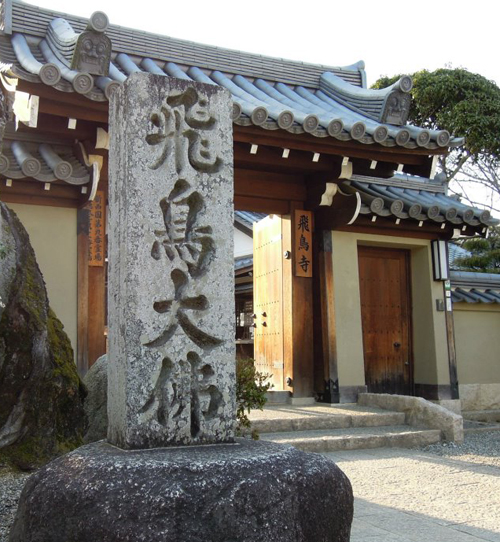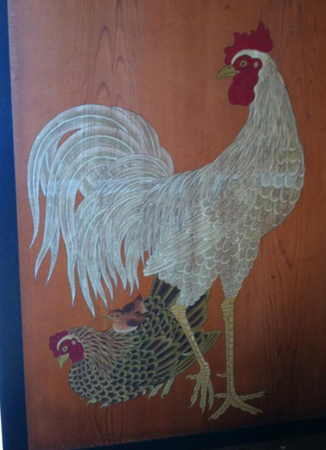196. The "Bird" Radical: 鳥
The 11-stroke "bird" radical 鳥 may look complicated, but it appears in just a smattering of Joyo kanji and never changes its shape.
In Very Few Joyo Kanji
The 鳥 radical is on duty in only four Joyo kanji:
鳥 (174: bird; chicken)
鳴 (209: to cry (animals); to bark; to ring; echo)
鶏 (1206: chicken)
鶴 (2072: crane)
And it's the off-duty radical in only one Joyo character:
島 (358: island)
Actually, it plays a poetic role in this last character, which combines 鳥 (bird) and 山 (mountain). Henshall presents the etymology as "mountains where birds alight," which is to say "islands in the sea." Lovely!
Part of a sign for a restaurant that serves fried chicken:
鶏 (とり: chicken)
から揚げ (からあげ: fried)
The Japanese Name とり
Just as we read the kanji 鳥 with the kun-yomi of とり, we can read the radical 鳥 as とり. It can go by the name とりへん when it appears on the left side of a kanji, but no Joyo characters have it there.
When it's on the right side, this radical qualifies as a とりつくり. It's in that position in all three Joyo kanji that contain this on-duty radical, aside from 鳥 itself.

Photo Credit: Yoshikazu Kunugi
Old, inscribed slab at Asuka-dera Temple in Nara. The writing on the stone is as follows:
飛鳥 (あすか: flying bird)
大佛 (だいぶつ: great Buddha)
The last kanji, which is non-Joyo, is the old form of 仏.
A Sound-Alike in English
Whereas 鳥 is the "bird" radical, Radical 172 is 隹 (ふるとり), the "old bird" radical. I don't think 隹 was named for an aged bird! Rather, multiple sources say that 隹 is called that because it's a component in the non-Joyo 舊, which is the former way of writing 旧 (old).
Nelson describes 隹 as a "less complicated" bird, as opposed to 鳥, which he deems a "long-tailed" bird!
Photo Credit: Eve Kushner
A parrot. The non-Joyo kanji for "parrot" is insanely busy: 鸚. Two seashells, a woman, and a bird! To convey "parrot," you need the compound 鸚鵡 (おうむ), which particularly refers to large types. The Japanese usually render this as オウム, rather than using two non-Joyo characters.
Incidentally, 鳥 and 隹 combine in several kanji, including these:
鶴 (2072: crane)
鷦 (ショウ: wren)
鵻 (こばと: pigeon)
鷹 (たか: hawk)
鸛 (こうのとり: Japanese stork)
All but the first are non-Joyo. As it turns out, 鳥 serves as the on-duty radical in quite a few non-Joyo characters that represent types of birds.
Photo Credit: Eve Kushner
A macaw, usually written in Japanese as こんごういんこ, though the kanji rendering 金剛鸚哥 is also possible.
A Look-Alike
As long as we're staying on our toes (talons?) about radicals that one can easily mix up, let's be sure to keep 鳥 and 馬 straight. The latter is Radical 187, the "horse" radical. It looks like a cross between 鳥 and 隹, doesn't it?
Photo Credit: Eve Kushner
Can you find three instances of 鳥 in this sign for a restaurant?! The first two aren't that hard; they appear in the top line in 焼鳥 (やきとり) and 鳥から揚げ (とりからあげ). The big writing contains the third bird in 地鳥庵. My proofreader says this should actually be 地鶏庵 (じどりあん), where 地鶏 (じどり) means "regional chicken specialty" and 庵 (あん) is a non-Joyo kanji meaning "shop." Incidentally, the remaining word in the top line is おでん酒場; おでん is a hot-pot dish traditionally eaten in winter, and 酒場 (さかば) means "bar." As for the vertical part, this shop (-店: -てん) is in the old part of Niigata, known as 古町 (ふるまち).
Etymologies of Kanji with 鳥
Let's look more closely at the role 鳥 plays in the four Joyo kanji in which it's the active radical.
鳥 (174: bird, chicken)
Henshall says that 鳥 is a pictograph of a bird. Here's what 鳥 used to look like, per Sears:

LST–seal style.

Oracle style.
Ah, the second one certainly seems pictographic!
Photo Credit: Corey Linstrom
At a kushiyaki (grilled skewers) place called 鳥茂 (とりしげ) in Shinjuku, Tokyo, the old-style characters on the noren (the slit curtain at the entrance) are 鳥茂. By the way, 茂 means "to grow luxuriantly," referring to bushes or weeds. It's possible that the 茂 relates to the owner's name, as in the surname 茂田 (しげた) or the male given names 茂 (しげる) or 茂雄 (しげお).
鳴 (209: to cry (animals); to bark; to ring; echo)
This kanji combines 口 (mouth) and 鳥 (bird), says Henshall. The character originally meant "bird call" (that is, the sound a bird makes, not the noise you might make to summon a bird). Then it broadened to include other animals and inanimate sources, such as bells.
Photo Credit: Eve Kushner
鶏 (1206: chicken)
In this kanji, the right side is definitely "bird," says Henshall. The left is a phonetic substitute for a more complex shape that means "cockscomb." Thus, 鶏 symbolizes "bird with cockscomb," which is to say "cock," "hen," or "chicken." Incidentally, the Joyo kun-yomi of にわとりtells us that a chicken is a bird (とり) of the garden (にわ).

Photo Credit: Taisaku Nogi
Image of feathered creatures at Yokokan (養浩館, ようこうかん), a historic estate in Fukui Prefecture.
鶴 (2072: crane)
The right side of 鶴 means "bird." On that everyone agrees.
According to Kanjigen, the left-side 寉 contributes sound and means “(bird that) soars high.” Because the same component appears in 確 (certain) and originally meant “white” there, Kanjigen asserts that it would be better to interpret the 寉 in 鶴 as "white," too. The reasoning strikes me as strange because one rarely finds such consistency in the kanji world.
Henshall defines the 寉 as “reach high up, fly” in his newer edition. He calls that left side a phonetic with one of two associated senses—either “(bird) calls/sings/chirps” or “white.” Either way, the whole character means “crane,” he says.

Photo Credit: Eve Kushner
A restaurant in San Francisco's Japantown is called 串鶴 (くしつる: Crane Skewers). I don't believe they actually serve cranes on skewers!
